Do your employees know what success looks like to you? Do they understand the specific role they play in achieving your business goals? If you haven’t told your employees what you expect, then you shouldn’t expect much. Setting expectations is a vital step that many business owners overlook. Whether you want to open a new location, create a new product, or increase your market share, your staff needs a compass and a roadmap for getting there.
Setting Expectations From the Start
Before you schedule the big employee meeting, take plenty of time to plan. Start by defining your business goals for the quarter, the next six months or the coming year. Break your biggest goals down into smaller, more manageable goals.
Expectations must be realistic and extremely specific, so make your goals realistic and extremely specific. If your annual growth rate is currently 26 percent and you expect it to increase to 40 percent, have you done the math? Do you have the necessary time, staff and financial resources to conceivably make that happen?
Setting expectations starts with setting goals. One helpful tool is the SMART model. It was introduced in 1954, but many business owners still benefit from it: Is the goal specific? Is it measurable? Is it actionable? Is it realistic and relevant? Is it time-bound? Another model, the OKR acronym for Objectives and Key Results, measures goal achievement according to results. OKR is widely used in Silicon Valley. In any case, as you define your goals, be optimistic while taking your limitations into account.

Goals Provide Context for Expectations
Goals in themselves don’t go far enough with employees. They might completely buy into your goals but still not know how to go about achieving them. Goals simply put expectations in context. They provide the “why.” Expectations, on the other hand, provide the game plan and define specific roles. They become the playbook that stimulates collaboration and productivity. Base your expectations on your goals, but don’t confuse the two. Your goals are not necessarily your employees’ goals, but your staff members still have to meet expectations if they want to remain on your payroll.
First, pinpoint the hindrances to achieving your goals. What’s holding up the show? What needs to change? Where is productivity lagging or communication breaking down? Don’t be surprised if at least some obstacles to success involve conflicts between people. Why does a company that seems to have a great product and business model start to self-destruct? For Marcus, that’s an easy question. It’s usually because of drama within the staff. That’s the situation he found at a southern California apparel design and supply company run by two brothers with conflicting managerial styles. Micromanagement and verbal abuse had morale at an all-time low. Employees simply can’t be productive in that kind of environment. As Marcus has said, “If the employees are happy, then the chances of the customer being happy are exponentially better.” One of your expectations should certainly address mutual respect and courteous speech.
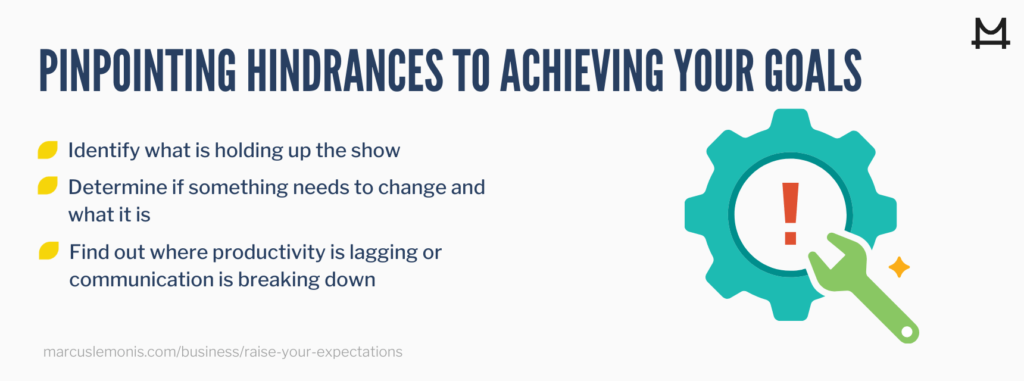
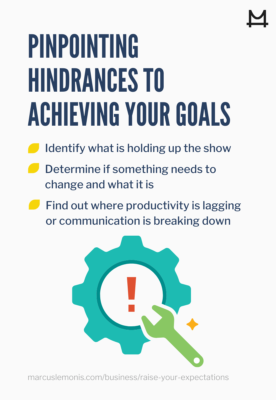
Managing Expectations in Business Calls for Input From Everybody
Make a list of overall expectations that apply to everyone. It should include a core, measurable standard of excellence that is fair to all. In order for it to be fair, you must use the same metrics to evaluate all employees. Once you have your overall expectations in place, bring your employees in on the rest of the process. You might get eye-opening feedback about challenges, such as a lack of resources, that you never knew existed. You might learn that your employees don’t understand your directives as well as you think they do. You might get an earful about someone’s management style that explains why one team’s productivity has fallen off. Discuss solutions as a group, and be open to input. Expectations are never one-size-fits-all, so you can’t rush this process. Depending on the size of your business, you might draw up a tailor-made list of expectations for each department, team or individual.
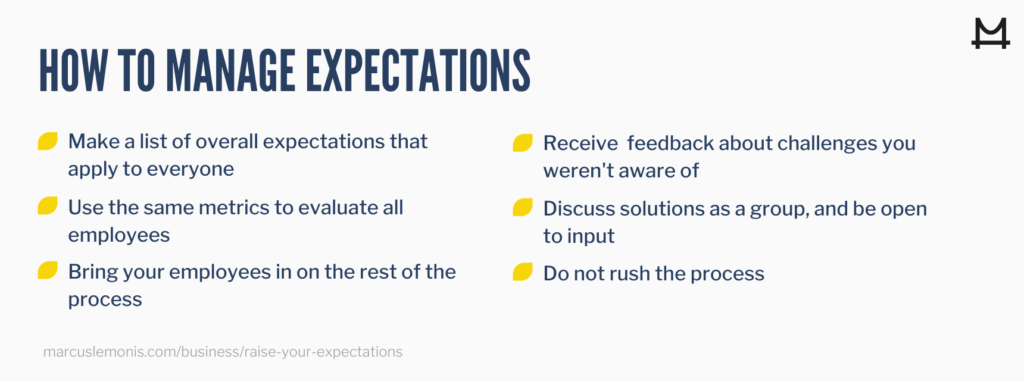

Expectations Should Reflect Both Owners’ and Employees’ Best Interests
The most successful companies are the ones that take sincere interest in their workers. They pay well and offer generous benefits. They emphasize communication and have an open-door policy. They invest heavily in employee resources and career and personal development. They’re fair and impartial. Coca-Cola is a good example. According to its webpage for job seekers, it is “committed to extending education and development programs to associates at all levels of the organization.” The corporate identity statement sums it up well: “One company. One team. One passion.”

You may not have Coke’s resources, but companies of all sizes find that it pays to keep employees’ best interests at heart. As you frame your expectations, bear that in mind. You want your expectations to boost morale rather than stoke fears. Verify that your staff has the knowledge, skills, training, resources and access to support that they need to do what you expect of them. Also, for best results, let your people know what they can expect from you. Be honest and transparent about the role you’ll play, and invite them to hold you to it. If you overpromise, you’re likely to underdeliver. You don’t have to promise the world, but you should provide clear incentives for employees to do their very best.
Above all, stress open, two-way communication. Start with the list of expectations itself. It should be simply written in a way that everyone can understand. Provide clear timelines, but be willing to be flexible; if communication is as open as it should be, this will be a living, dynamic document that’s tweaked according to results, company growth and new challenges. Finally, have everyone sign off on the document. People are more likely to remember a commitment if they write it down, and signing ensures that everyone is accountable and on the same page.
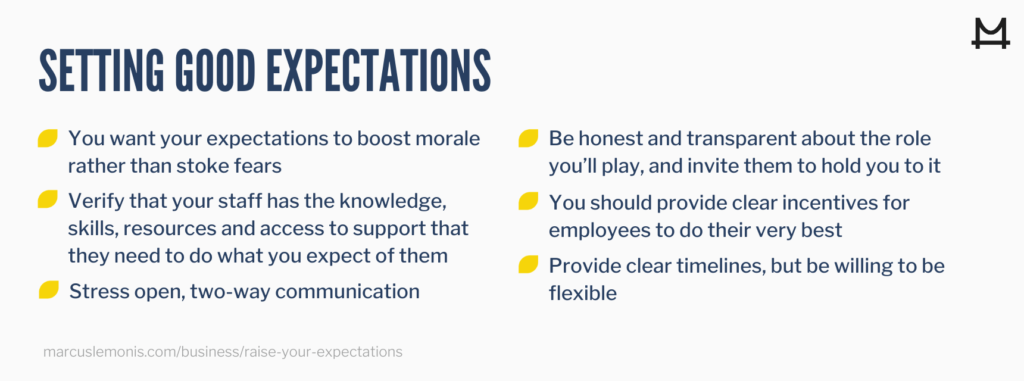
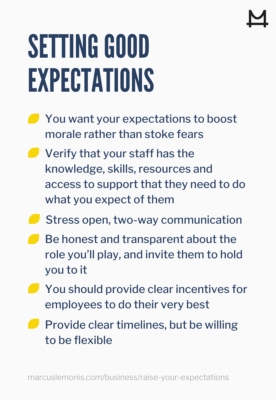
Managing Expectations Throughout
Business priorities fluctuate all the time, so it’s crucial to regularly follow up with your employees. This prevents unpleasant surprises at yearly performance reviews. Carve out five or ten minutes for give-and-take feedback with each employee at least once a week. If someone’s missing the mark — and that might be you — you’ll catch it early. Updates on delays or increased risk should be provided in as close to real time as possible so that you can implement a Plan B. Remember that setting expectations in business is about more than managing tasks, meeting deadlines and measuring financial results. Are employees professional and respectful? Are they working with integrity? Are they on time, engaged and upbeat each day? Do they follow procedures and safety rules? All these things should be included in your expectations, so there’s a lot to cover. One-on-ones keep the lines of communication open and reduce employee turnover.

Raising Expectations and Continuing to Improve
“In any business,” Marcus says, “you can’t become complacent. If you do, you’re going to go backwards.” You should celebrate good results and publicly acknowledge employees who exceed expectations, but continually raise the bar. Ask your workers about their own goals for the coming year. Take an interest in their plans for personal and professional development. If there’s a way that you can contribute, by all means do. When employees stagnate, businesses stagnate.
Two Louisiana-based friends and businesswomen got the idea to start a company during a trip to Portugal. All they needed were skilled commercial seamstresses to craft their unique cork-based products. They saw an opportunity to get the help and practice social responsibility at the same time. Their company partnered with a nonprofit that trains young people in skills or trades, and the owners were delighted by the talent they found there.

Marcus later took key employees to a successful, similar outfit in New York so that they could observe and hone their own skills. The company was soon able to expand its product line and enter new markets. That’s exactly the right mindset. Continually give your staff opportunities to grow and improve.
Managing expectations in business and continually raising the bar takes extra time and effort. You may not think you’re up for it, but you’ll be glad you made the investment when your company starts to grow and expand. Marcus can’t say it enough, “Trust the process.”
- How have you been managing expectations for your business?
- What areas of your business can you strive to improve in?





